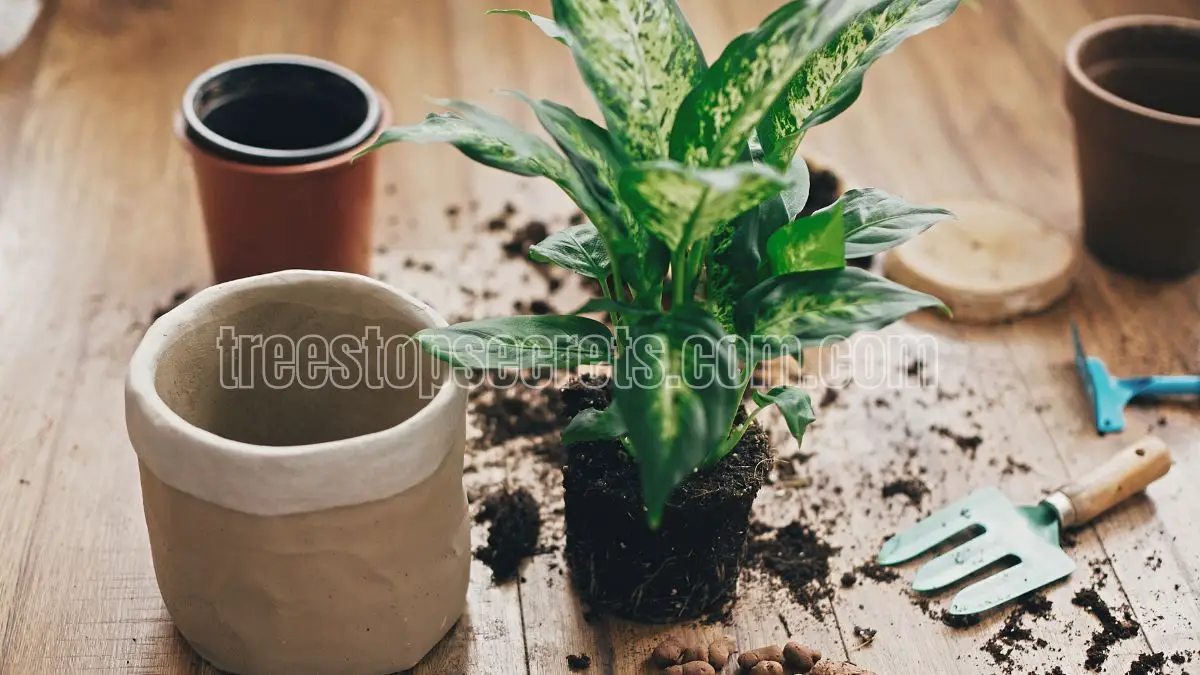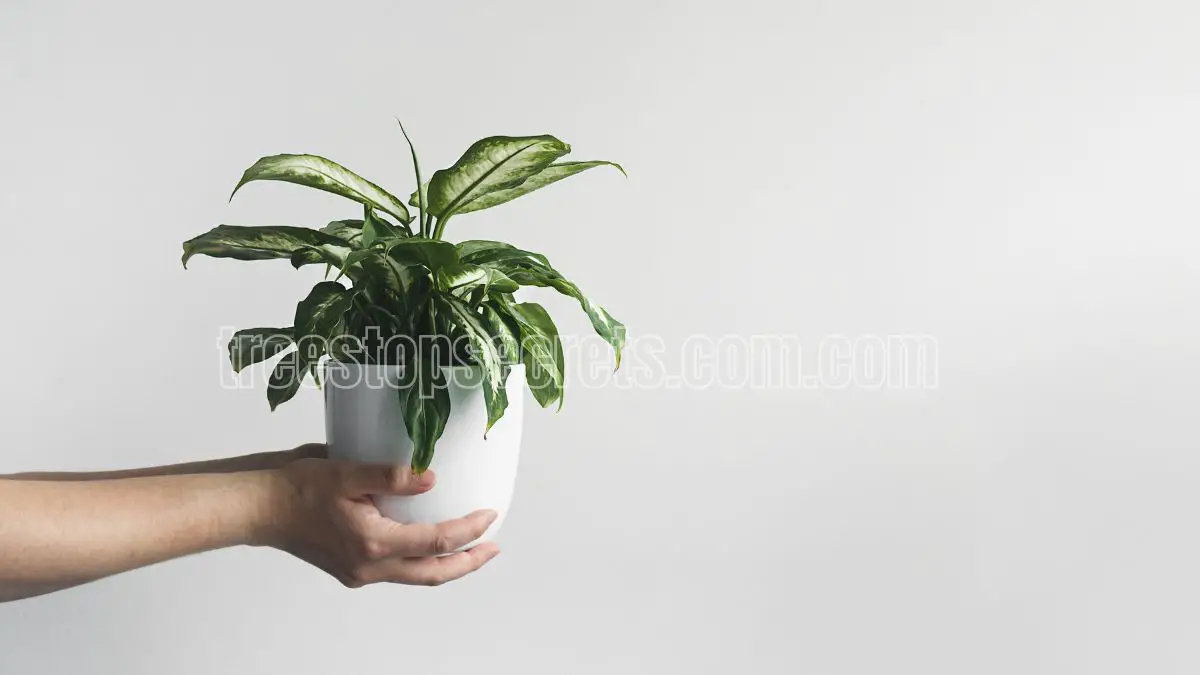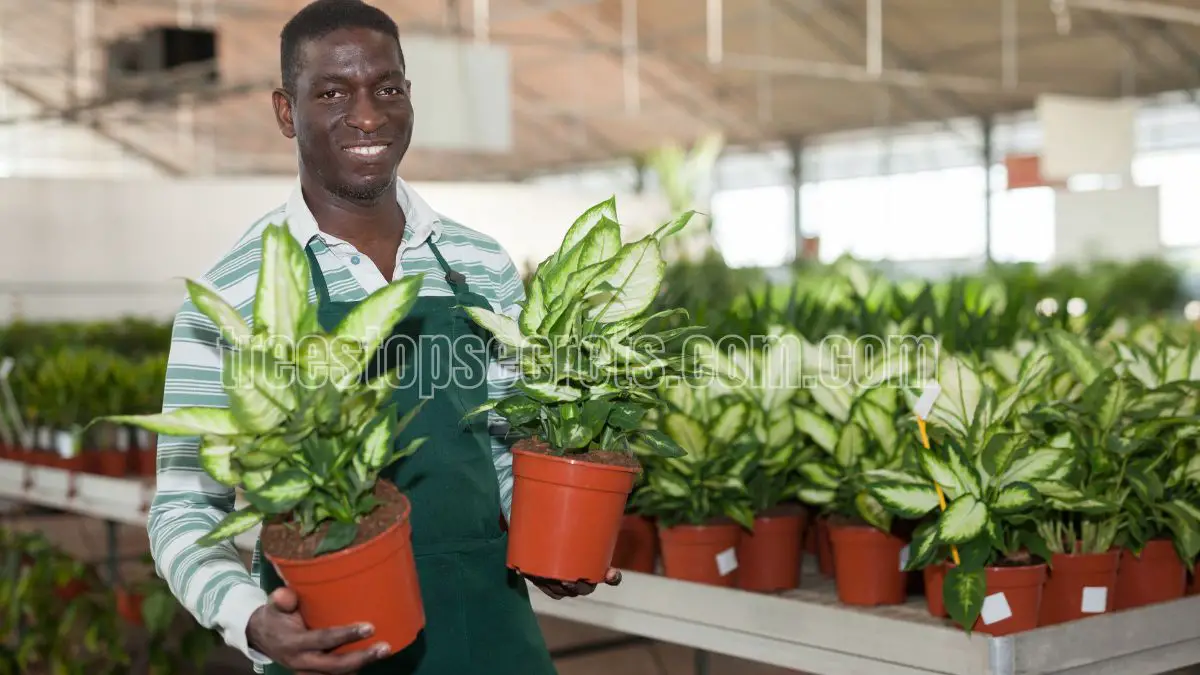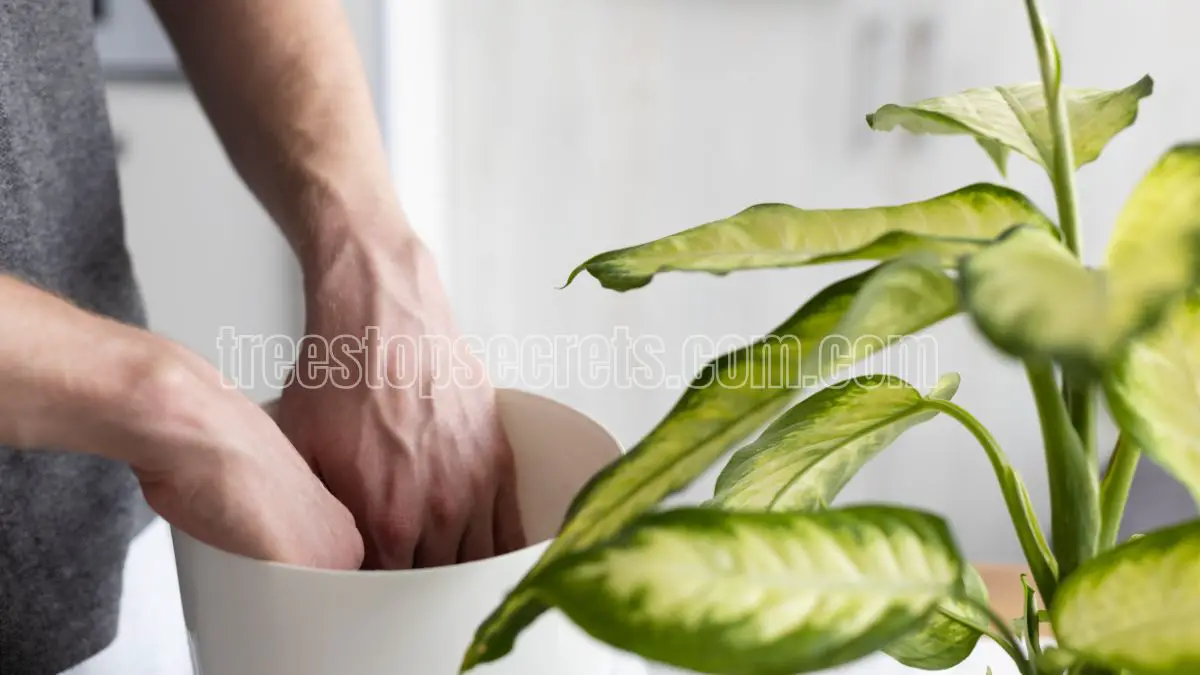Taking a few easy steps will ensure your plant continues to grow and flourish. These trendy tropicals, aka dumb canes, love bright, indirect light and well-draining soil. Water only when the top inch of soil is dry to the touch, and be careful not to overwater or your dieffenbachia will develop root rot.
Keeping Dieffenbachia in a consistently warm environment, preferably in the range of 65°F to 80°F, ensures the plant will thrive. Frequent dusting of the leaves will help improve photosynthesis and general health.
With proper care, your dieffenbachia can be a beautiful and lush addition to your home, bringing a little slice of nature indoors. In this guide, we’ll share expert advice and effective strategies for keeping your dieffenbachia healthy and thriving for years to come.
Key Takeaways
- Dieffenbachia, or “dumb cane,” as it’s more commonly known, is a popular indoor plant because of its vibrant foliage and air-purifying properties. Knowing what dieffenbachia likes and wants is key to keeping this popular houseplant thriving.
- Provide your dieffenbachia with bright, indirect light so the leaves don’t burn. Monitor the plant’s response to its environment and modify the light exposure accordingly.
- Water the plant thoroughly when the top 2 to 5 centimeters of soil is dry. Establish a routine. Water every week or every two weeks and maintain even moisture so it doesn’t dry out or become too soggy.
- Plant your dieffenbachia in a well-draining soil mix and fertilize monthly during the growing season to encourage healthy growth. Keep an eye on environmental factors like temperature and humidity. For best results, maintain temperatures in the range of 60 to 85 degrees Fahrenheit.
- Keep an eye on your plant and check for pests or other health concerns such as yellowing leaves or droop. Fix any issues right away to ensure the plant thrives.
- Explore some of the most popular dieffenbachia varieties, including ‘Camille’ and ‘Tropic Snow.' With their striking beauty and low-maintenance needs, dieffenbachia are easy to customize to your indoor space and care habits.
Understanding Dieffenbachia
Dieffenbachia, known popularly as “dumb cane,” makes a super indoor plant. Its full, patterned leaves and low maintenance needs have made it a houseplant favorite among plant keepers. This genus of ornamental perennials thrives in the tropical jungles of Central and South America.
Second, they’re really big! They can reach heights of 10 feet! Its common name derives from its toxicity. It’s mild to moderately poisonous if ingested, so be sure to keep it out of the reach of your more adventurous pets and children.
Besides its ornamental beauty, dieffenbachia is great at purifying the air, as it can remove harmful pollutants.

What is Dieffenbachia?
Dieffenbachia is noted for its big, tapering, ovate leaves patterned with variegations of green, cream, and white. Within this dieffenbachia genus, there are many different species of dieffenbachia with distinct characteristics, all adding to its popularity as an air-purifying houseplant.
Understanding its growth habits is essential. Under the right conditions, Dieffenbachia can grow taller than you would want indoors, even if it will become bushy in a pot. Identifying dieffenbachia’s ideal conditions—light, watering schedule, temperature—will set you on the right path to growing this plant indoors.
Why Choose Dieffenbachia for Indoor Spaces?
Secondly, dieffenbachia is extremely low maintenance, making it a great choice for beginner plant parents. Its exotic beauty adds richness to residential and commercial interiors alike.
Dieffenbachia is very versatile in terms of light exposure, flourishing in bright, indirect sunlight but will withstand some sun as well. It is one of the best natural humidifiers, improving indoor humidity levels.
Monitor the soil moisture often to avoid overwatering. You can check this by sticking your finger into the soil up to the first knuckle.
Optimal Care for Indoor Dieffenbachia
There are a few simple care practices that go a long way toward keeping your dieffenbachia healthy. Every single one—from light to humidity—has a critical part in ensuring robust, lush growth.
1. Ideal Light Conditions for Growth
Dieffenbachia does best in medium to bright, indirect light, so east- or west-facing windows are the perfect spot. In order to prevent leaf burn, intense direct sunlight must be filtered.
Symptoms of lighting problems are yellowing leaves for too much light and leggy growth for not enough light.
2. Watering Frequency and Techniques
The best practice is to water only when the top 1 to 2 inches of soil feels dry. An even routine of weekly or every other week is best.
Make sure the container has adequate drainage holes to avoid causing root rot. To ensure you’re watering appropriately, test the moisture level by inserting your finger into the soil.
Allow the water to run out of the bottom of the pot to make sure it drains well.
3. Soil Mix and Fertilization Schedule
Proper dieffenbachia care requires a fast-draining potting mix. Feed every two weeks with a diluted liquid fertilizer during the growing season (March-September).
Selecting a potting mix that holds moisture while still allowing proper aeration is essential.
4. Temperature and Humidity Requirements
They thrive in a temperature range between 60-85°F. It can tolerate humidity as low as 40 percent, though much higher humidity levels will help it thrive.
In particularly dry environments, a humidifier is a great way to keep humidity levels where they should be.
5. Safe Pruning Practices
Not only does pruning encourage bushier growth, it helps get rid of dead or dying leaves. Tools should be clean and sharp to avoid introducing disease.
To maximize the health and appearance of your dieffenbachia, prune it during the growing season.
Identifying and Solving Common Problems

Although Dieffenbachia plants, commonly known as dumb cane plants, are generally easy to maintain, those that do develop problems can suffer from issues such as brown leaf edges and yellow leaves. Early diagnosis is critical to addressing these problems effectively, so a robust inspection process should focus on preventing issues from developing into larger safety hazards.
Early Signs of Pest Infestation
Common pests that invade dieffenbachia plants are spider mites and mealybugs. Telltale signs of these infestations include webbing on the undersides of leaves, or a sticky saplike substance on furniture or floors.
Prevention is key when it comes to pest infestations. Checking for pests needs to be a new normal, especially in summertime when pest infestations are at their peak. Preventive measures such as keeping humidity high, applying neem oil sprays, and washing leaves often can help avoid these pests.
Solutions for Yellowing or Browning Leaves
Yellowing leaves is usually a sign of too much water or sun. Watering deeply and evenly—keeping the soil evenly moist but not waterlogged—can help prevent this problem.
Similarly, if the plant is in direct sunlight, relocating it to a place with bright, indirect light should do the trick. At other times, the yellowing of older leaves is simply the plant’s normal course, so it’s important to keep an eye on soil moisture levels.
Addressing Drooping Leaves and Stunted Growth
Drooping leaves can be a sign of underwatering or a lack of nutrients. Simply checking soil moisture and watering less frequently can go a long way to bringing back a sad plant.
If you suspect nutrient deficiencies, apply a balanced fertilizer. A simple checklist of actions you can take will save needless steps and speed your recovery.
Recognizing Nutrient Deficiencies
Signs of nutrient deficiencies include yellowing leaves or slow growth. Proper balanced fertilization contributes to plant health and vigor.
Applying an all-in-one solution like Turf Titan™ Fertilizer & Soil Builder solves these problems and more. For instance, yellowing between the veins is a telltale indicator of a magnesium deficiency.
Best Dieffenbachia Varieties for Indoor Growth

Dieffenbachia, commonly known as dumb cane plants, are celebrated for their stunning foliage and large leaves, making them wonderful accent plants in indoor spaces. Choosing the correct cultivar is crucial to ensure your new plant thrives in your home environment, as various dieffenbachias have unique care requirements.
Overview of Popular Varieties
The most popular dieffenbachia varieties include ‘Camille’ and ‘Tropic Snow.’ ‘Camille’ is a variety popular for its beautiful, wide leaves which feature an eye-catching contrast of dark green and creamy white.
The variety ‘Tropic Snow’ is particularly popular because of its speckled appearance. That bright, almost neon green hue really stands out against the creamy background. Both varieties thrive under bright, indirect light, which helps keep their striking colors alive.
| Variety | Leaf Shape | Coloration | Light Requirements | Watering Needs |
|---|---|---|---|---|
| Camille | Broad and oval | Dark green with creamy white | Indirect light | Moderate, allow topsoil to dry between waterings |
| Tropic Snow | Lanceolate | Bright green with cream spots | Indirect light | Keep consistently moist, but avoid soggy soil |
Specific Care Tips for ‘Camille’ and Others
For ‘Camille’, make sure it gets bright, indirect light. Too much direct sun will burn its leaves. Water whenever the top one inch of soil is dry to the touch as this will help avoid root rot.
Avoid sudden temperature fluctuations as ‘Camille’ can be quite temperamental, so keeping her climate-controlled is important. Monitor your plant closely. As you make changes based on your plant’s progress, you will cultivate a healthy, bright presence in your home.
Propagation Techniques for Dieffenbachia
Whether you’re adding more tropical plants to your indoor garden or getting new dieffenbachia plants for friends or family, propagating dieffenbachia is a rewarding process.
Propagation 101
Healthy parent plants, like the dieffenbachia, are crucial for successful propagation, as their vigor directly influences the new growth of large leaves and roots, ensuring robust and healthy dieffenbachia plants.
Methods for Successful Propagation
The most popular technique of propagation is by taking stem cuttings. Choose a stem with a minimum of two leaves and make the cut just below a node. Put the cutting in water or wet soil, making sure it doesn’t fall over.
A second method of propagation is air layering, where roots are encouraged to grow on a cutting while it remains connected to the mother plant. First, take a stem cutting and dip it in rooting hormone. Then cover the exposed stem with moist moss and plastic wrap to retain moisture.
Regardless of the propagation method chosen, keeping medium consistently moist is important for roots to form.
- Steps for Propagating Dieffenbachia: Methods for Successful Propagation
-
Select a healthy cutting or air layer.
-
Make a cut just below a node.
-
Moisten the medium.
-
Root growth should be monitored.
Maintaining Plant Health During Propagation
Making sure the cutting has proper light and humidity conditions are very important. Keeping cuttings in a bright, indirect light environment will help minimize leaf scorch.
Proper soil moisture is key as well; excess or insufficient moisture will prevent root growth. Implementing sterile tools and equipment helps you avoid disease and establishes a standard practice during the process.
Things to keep in mind: Remember that patience is important as new roots can take several weeks to form.
Enhancing Your Indoor Environment
Adding a dieffenbachia to your home will beautify your space while helping to purify the air around you. Renowned for its lavish, verdant leaves and bold variegations, dieffenbachia makes a dramatic decor statement in any space. In addition to its aesthetic value, dieffenbachia has a proven ability to filter toxins from the air and improve your indoor environment.
The colorful foliage brings everything to life, making even the most unremarkable corner a beautiful and inviting space. To make your home even more lively, be sure to complement your dieffenbachia with other houseplants such as pothos or peace lilies. This pairing can turn your indoor space into a verdant paradise, providing you with different textures and colors.
Set up a plant nook to bring your space to the next level. Like any good garden, it offers a peaceful escape from the clamor of everyday life.
Optimizing Light, Humidity, and Temperature
If you want a healthy, beautiful dieffenbachia, make sure to provide the right amount of light. Make sure to put it in bright, indirect light, because direct sunlight will burn its leaves. Holding your humidity level at the right point is important.
Using a humidifier and/or setting a tray of water to evaporate near your houseplant should do the trick. When it comes to temperature, your plant should be located in an environment where the temperature ranges from 65-80°F, with no drafts or direct heat sources.
A checklist for environmental adjustments includes:
- Provide bright, indirect light.
- Maintain humidity above 50%.
- Keep temperatures stable.
Comparing Dieffenbachia Care to Other Houseplants
Dieffenbachia care is quite comparable to other tropical plants, particularly when considering how to water dieffenbachia properly. It does need a little more attention to prevent overwatering, making it essential to understand the unique needs of this dumb cane plant alongside popular choices like snake plants and ferns.
Troubleshooting Tips for Common Issues
Conclusion Successfully treating dieffenbachia issues takes the right approach and quick response. If you act quickly you can restore your plant’s health and keep it looking beautiful.
Keeping a care journal helps track issues and document solutions, providing valuable insights for future care.
Effective Solutions for Common Dieffenbachia Problems
Common dieffenbachia problems are pests like spider mites and mealybugs, as well as leaf yellowing. Dealing with pests requires vigilance. To prevent infestations, be sure to check the undersides of leaves and stems often.
Applying insecticidal soap or neem oil to the entire plant are effective organic treatments for severe infestations. When it comes to leaf discoloration, light exposure and watering frequency are the most important factors to consider.
Preventative measures include keeping humidity levels high and providing good air circulation around the plant. Here’s a quick list of fixes:
- Remove infested leaves.
- Increase humidity with a pebble tray or misting.
- Adjust watering schedules to prevent over or under-watering.
Seasonal Adjustments for Optimal Growth
Seasonal adjustments have a major impact on dieffenbachia care practices. During the winter, introduce an even drier spell of dormancy with less watering, and provide plenty of bright, indirect light.
In spring and summer, water more often and provide the plant with sunnier conditions so it can thrive. A checklist for seasonal adjustments includes:
- Watering frequency changes.
- Light exposure adjustments.
- Humidity monitoring and adjustments.
Conclusion
Caring for an indoor dieffenbachia plant adds beauty and interest to your home or office. By taking a few simple precautions, you can enjoy your dieffenbachia plant for years to come. Give it bright, indirect light and water well but do not let it sit in a soggy medium. Monitor for pests and low humidity to prevent stressors from affecting your plant. Pick your perfect variety, and bask in the beauty that they all have to offer in your home.
Frequently Asked Questions
How much light does a Dieffenbachia need?
How much light does a dumb cane plant need? Do not place it in direct sun, as this will burn the foliage. To promote healthy leaves on your Dieffenbachia, a north or east-facing window is best.
How often should I water my Dieffenbachia?
When to water Dieffenbachia, or the dumb cane plant, is crucial; water your tropical plant whenever the top inch of soil is dry, typically 1-2 times a week.
Is Dieffenbachia toxic to pets?
To avoid toxic reactions, always keep the dumb cane plant, or Dieffenbachia, out of the reach of pets like cats and dogs.
What temperature is best for Dieffenbachia?
What temperature is best for a dieffenbachia plant indoors? Don’t place it in the path of cold drafts or near heat sources.
How can I tell if my Dieffenbachia is overwatered?
Yellowing leaves and a soft stem are signs of overwatering your dieffenbachia plant. Ensure your pot has good drainage and increase the intervals between watering if you start seeing these signs.
Can I grow Dieffenbachia in low light?
Although the dieffenbachia plant thrives in low light, its growth may be slow, leading to a leggy appearance. To keep this tropical plant at its best, aim for brighter conditions with some indirect light.
How do I propagate Dieffenbachia?
To propagate a dieffenbachia plant, select a healthy stem with large leaves and cut just below a node. Place it in water or fresh soil, ensuring a warm, humid environment until roots form.
Image Source: Paid image from CANVA


